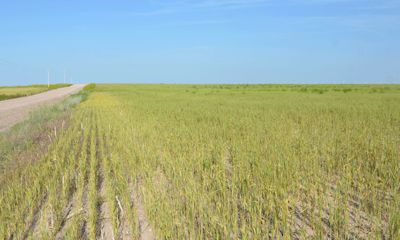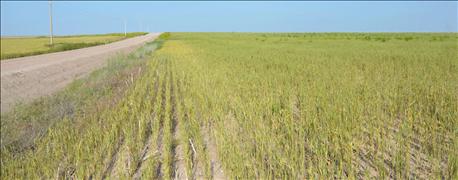June 25, 2016

By far, the greatest risk of losses from mite-vectored viruses occurs when there is a summer "green bridge" of volunteer wheat emerging before harvest. This almost always occurs as a result of wheat seed head shatter from hail storms.
The mites and viruses survive the summer on this "green bridge," then the mites move from volunteer wheat to newly emerged winter wheat plants in the fall, transmitting the viruses. Mites can transmit wheat streak mosaic virus, High Plains virus, and Triticum mosaic virus, creating the likelihood of some very severe mixtures of viral infections.

CONTROL THE GREEN BRIDGE: Mites survive the summer on the "green bridge" and move from volunteer wheat to newly emerged winter wheat plants in the fall, transmitting viruses like wheat streak mosaic virus, seen in this photo of a winter wheat field in Kimball County taken last year.
Mites depend on wind for dispersal. In the fall, as mite populations increase, they leave the protected areas of volunteer wheat plants (rolled leaves and whorls) and crawl to leaf tips or other exposed areas where they become airborne. After landing on a new host, the mites crawl to the youngest leaf and begin to feed and reproduce.
In heavily infested volunteer wheat, most mites will carry the virus. Transmission to the young winter wheat plants requires only a few infected individuals. Immature mites acquire the virus in as little as 15 minutes as they feed on infected leaves. Mites remain active for most of their lives (two to four weeks or longer with cool temperatures), but the transmission efficiency of adult mites decreases with age.
Research has found that mites can survive up to 24 hours under low temperatures. So, a significant number of mites may be transported by the wind from greater distances than originally thought; however, the greatest risk is to the field closest to the volunteer wheat.
Volunteer wheat isn't the only host for the wheat curl mite. Recent research has evaluated the suitability of weedy grasses as hosts for both the curl mite and the wheat streak virus. Barnyardgrass topped the list in terms of suitability for both virus and mites, but fortunately it isn't a common grass in wheat except in low areas like terraces. In contrast, green foxtail is a poor host but could be an important disease reservoir because of its abundance.
In one example the source of a winter wheat field infected with wheat streak mosaic virus was a grain sorghum field with grassy weeds adjacent to the winter wheat field. Take note of significant stands of these grasses where they can be treated and control them as you would volunteer wheat.
~~~PAGE_BREAK_HERE~~~
Timely weed control helps manage yield loss risk
Risks from not controlling volunteer wheat and weeds include:
• Pre-harvest volunteer wheat can cost you or your neighbor the value of next year's winter wheat crop due to loss from wheat viruses. While both pre- and post-harvest control of the “green bridge” are important, timely control of pre-harvest volunteer wheat will have a greater impact on ultimately reducing virus transmission and yield loss.
• Uncontrolled volunteer wheat and weeds can cost you 30 to 100 bushels per acre of corn or sorghum the next year due to soil moisture loss.
• Weed control may be more difficult and expensive in next year's crop.
• Planting the next crop may be more difficult in last year's stubble.

Comparison of the increased risk of pre-harvest volunteer wheat (usually from hail storms) versus post-harvest volunteer wheat in the development of wheat streak mosaic. (Source: Justin McMechan, UNL doctor of plant health & entomology graduate student).
Impact of wheat seeding time
The earlier the winter wheat is seeded and the longer mild weather extends through the fall, the greater the risk of spreading wheat streak mosaic and other viral infections.
Reproduction and spread of mites stop with cool temperatures in the fall; however, mites can survive cold winter temperatures. The virus survives the winter within the plant, and the mites survive as eggs, nymphs, or adults protected in the crown of the wheat plant. As winter wheat greens up in the spring, mites become active and the virus may be spread to healthy winter wheat plants or to emerging spring wheat, although this is less of a threat than fall transmission.
Volunteer wheat surviving through the summer and fall creates numerous risks for the subsequent wheat crop as well as other rotated crops. Controlling volunteer wheat will reduce the risks from these threats and ultimately improve the bottom line.
For herbicide options to control volunteer wheat and annual grasses, check the 2016 Guide for Weed, Disease, and Insect Management in Nebraska, EC130.
Source: UNL CropWatch
You May Also Like




